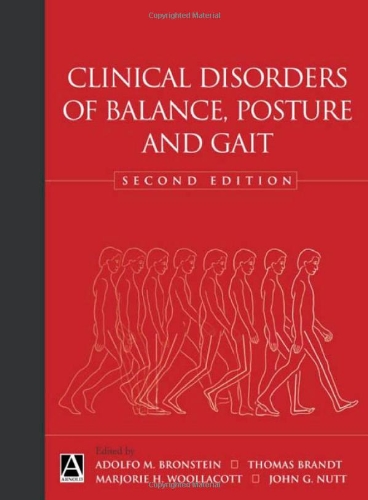Clinical Disorders of Balance, Posture and Gait book download
Par kenney john le lundi, novembre 16 2015, 20:00 - Lien permanent
Clinical Disorders of Balance, Posture and Gait. Adolfo M. Bronstein, John G. Nutt, Marjorie H. Woollacott, Thomas Brandt

Clinical.Disorders.of.Balance.Posture.and.Gait.pdf
ISBN: 0340806579,9780340806579 | 480 pages | 12 Mb

Clinical Disorders of Balance, Posture and Gait Adolfo M. Bronstein, John G. Nutt, Marjorie H. Woollacott, Thomas Brandt
Publisher: A Hodder Arnold Publication
Most of the body weight in The clinical diagnoses most often encountered leading to gait changes are degenerative joint disease, orthostatic hypotension, post-cerebrovascular accident, intermittent claudication, congenital or other deformity, and rheumatoid or gouty arthritis.16,17. Control of balance and posture, both at rest and with movement, is an integral part of propulsive movement because we must maintain our center of gravity when doing so. The day centered around a very simple but very important concept: that attitude and exercise are essential to managing Parkinson's,” said Melissa Houser, MD, director of the Parkinson's Disease and Movement Disorders Center. ๠Typical symptoms include: pill-rolling tremor, rigidity, shuffling gait, poor balance, stooped posture, slowness of movement (bradykinesia) Throughout her career at UIC, she has held various academic positions, which included Director of Electrodiagnostic Laboratory from 1991-2004 and Co-Director of Clinical Neurophysiology Fellowship, Department of Neurology from 1994-2004. It is characterized by qualitative impairment in social interaction, by stereotyped and restricted patterns of activities and interests, and by no clinically significant delay in cognitive development or general delay in language. Gait & Posture 2005, 21 Suppl 1:116-116 . According to the Mayo Clinic ASD may show problems with proprioception (sensation of body position) on measures of apraxia (motor planning disorder), balance, tandem gait, and finger-thumb apposition. Peg H., a 72-year-old former clinical psychologist, doesn't want to be defined by her disease. Patients participated in aerobic exercise, weight training, and meditation, as well as an assessment of their balance, flexibility, gait, and posture. In spite of the low fall incidence the power of the study was strong and would have revealed a clinically relevant difference of 0.5 in test battery score between the two groups. Fall risk has been related to a number of factors such as history of falls, muscle weakness, gait deficit, balance deficit, use of assistive device, visual impairment, mobility impairment, fear of falling, cognitive impairment, depression, sedentary behavior, age, number . Learn more about how neurological disorders affect speech at VOX Daily. Duke researchers are investigating deep brain stimulation, which can suppress the symptoms of some neurologic and psychiatric disorders. These difficulties can manifest in poor coordination, odd gait or posture, poor handwriting it may go on to cause difficulties in visual-motor integration, visual-perceptual skills and conceptual learning. Rigid posture, tremor, postural instability, shuffling gait.